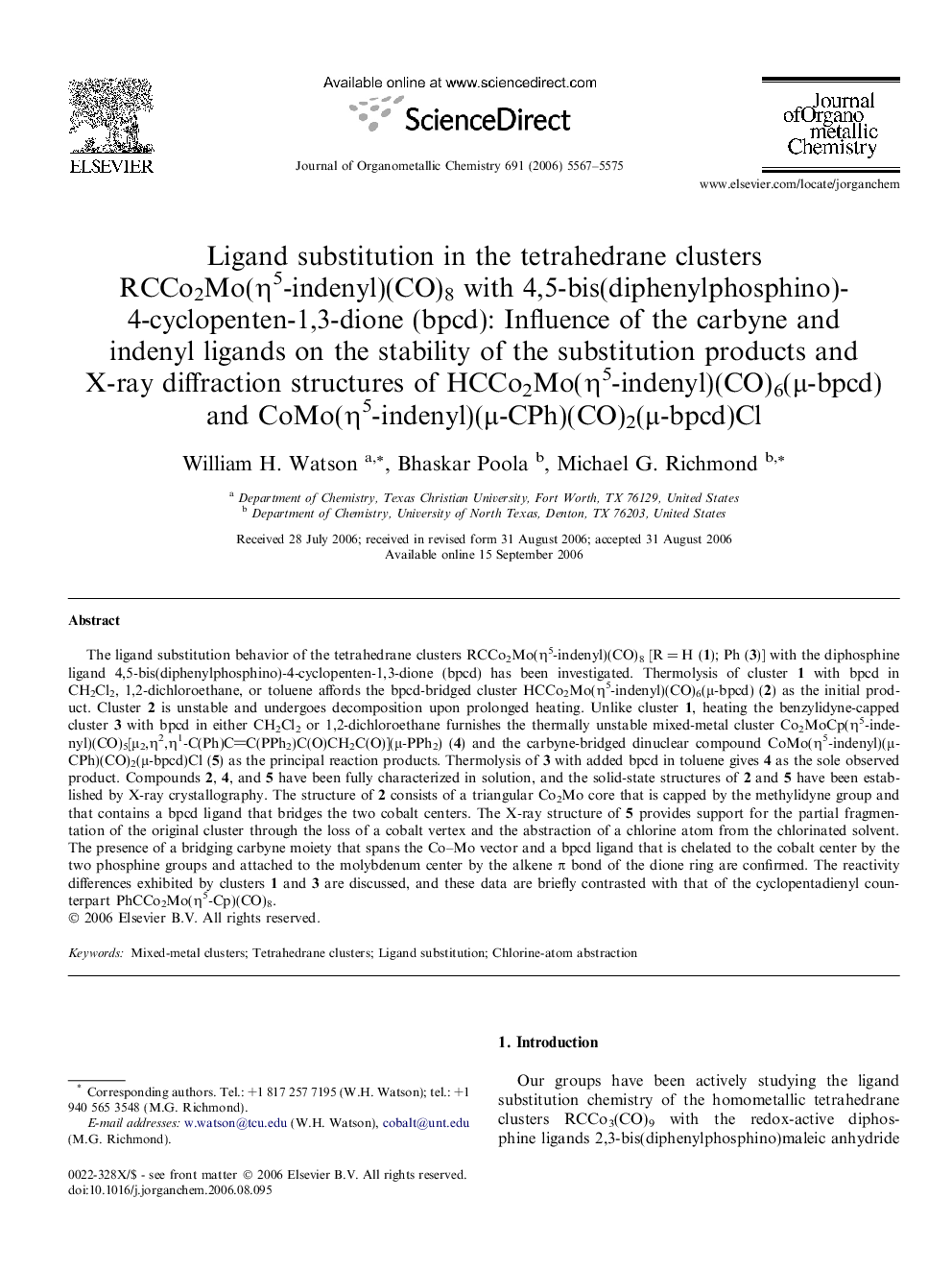| کد مقاله | کد نشریه | سال انتشار | مقاله انگلیسی | نسخه تمام متن |
|---|---|---|---|---|
| 1328378 | 977569 | 2006 | 9 صفحه PDF | دانلود رایگان |

The ligand substitution behavior of the tetrahedrane clusters RCCo2Mo(η5-indenyl)(CO)8 [R = H (1); Ph (3)] with the diphosphine ligand 4,5-bis(diphenylphosphino)-4-cyclopenten-1,3-dione (bpcd) has been investigated. Thermolysis of cluster 1 with bpcd in CH2Cl2, 1,2-dichloroethane, or toluene affords the bpcd-bridged cluster HCCo2Mo(η5-indenyl)(CO)6(μ-bpcd) (2) as the initial product. Cluster 2 is unstable and undergoes decomposition upon prolonged heating. Unlike cluster 1, heating the benzylidyne-capped cluster 3 with bpcd in either CH2Cl2 or 1,2-dichloroethane furnishes the thermally unstable mixed-metal cluster Co2MoCp(η5-indenyl)(CO)5[μ2,η2,η1-C(Ph)CC(PPh2)C(O)CH2C(O)](μ-PPh2) (4) and the carbyne-bridged dinuclear compound CoMo(η5-indenyl)(μ-CPh)(CO)2(μ-bpcd)Cl (5) as the principal reaction products. Thermolysis of 3 with added bpcd in toluene gives 4 as the sole observed product. Compounds 2, 4, and 5 have been fully characterized in solution, and the solid-state structures of 2 and 5 have been established by X-ray crystallography. The structure of 2 consists of a triangular Co2Mo core that is capped by the methylidyne group and that contains a bpcd ligand that bridges the two cobalt centers. The X-ray structure of 5 provides support for the partial fragmentation of the original cluster through the loss of a cobalt vertex and the abstraction of a chlorine atom from the chlorinated solvent. The presence of a bridging carbyne moiety that spans the Co–Mo vector and a bpcd ligand that is chelated to the cobalt center by the two phosphine groups and attached to the molybdenum center by the alkene π bond of the dione ring are confirmed. The reactivity differences exhibited by clusters 1 and 3 are discussed, and these data are briefly contrasted with that of the cyclopentadienyl counterpart PhCCo2Mo(η5-Cp)(CO)8.
Thermolysis of the mixed-metal cluster HCCo2Mo(η5-indenyl)(CO)8 (1) with the diphosphine ligand 4,5-bis(diphenylphosphino)-4-cyclopenten-1,3-dione (bpcd) in DCM or DCE solvents yields the bpcd-bridged cluster HCCo2Mo(η5-indenyl)(CO)6(μ-bpcd) (2). The related benzylidyne-capped cluster PhCCo2Mo(η5-indenyl)(CO)8 (3) reacts with bpcd under analogous conditions to give the unstable cluster Co2MoCp(η5-indenyl)(CO)5[μ2,η2,η1-C(Ph)CC(PPh2)C(O)CH2C(O)](μ-PPh2) (4) and the carbyne-bridged compound CoMo(η5-indenyl)(μ-CPh)(CO)2(μ-bpcd)Cl (5). These compounds have been fully characterized in solution by IR and NMR spectroscopies, and by X-ray crystallography in the case of compounds 2 and 5.Figure optionsDownload as PowerPoint slide
Journal: Journal of Organometallic Chemistry - Volume 691, Issue 26, 15 December 2006, Pages 5567–5575